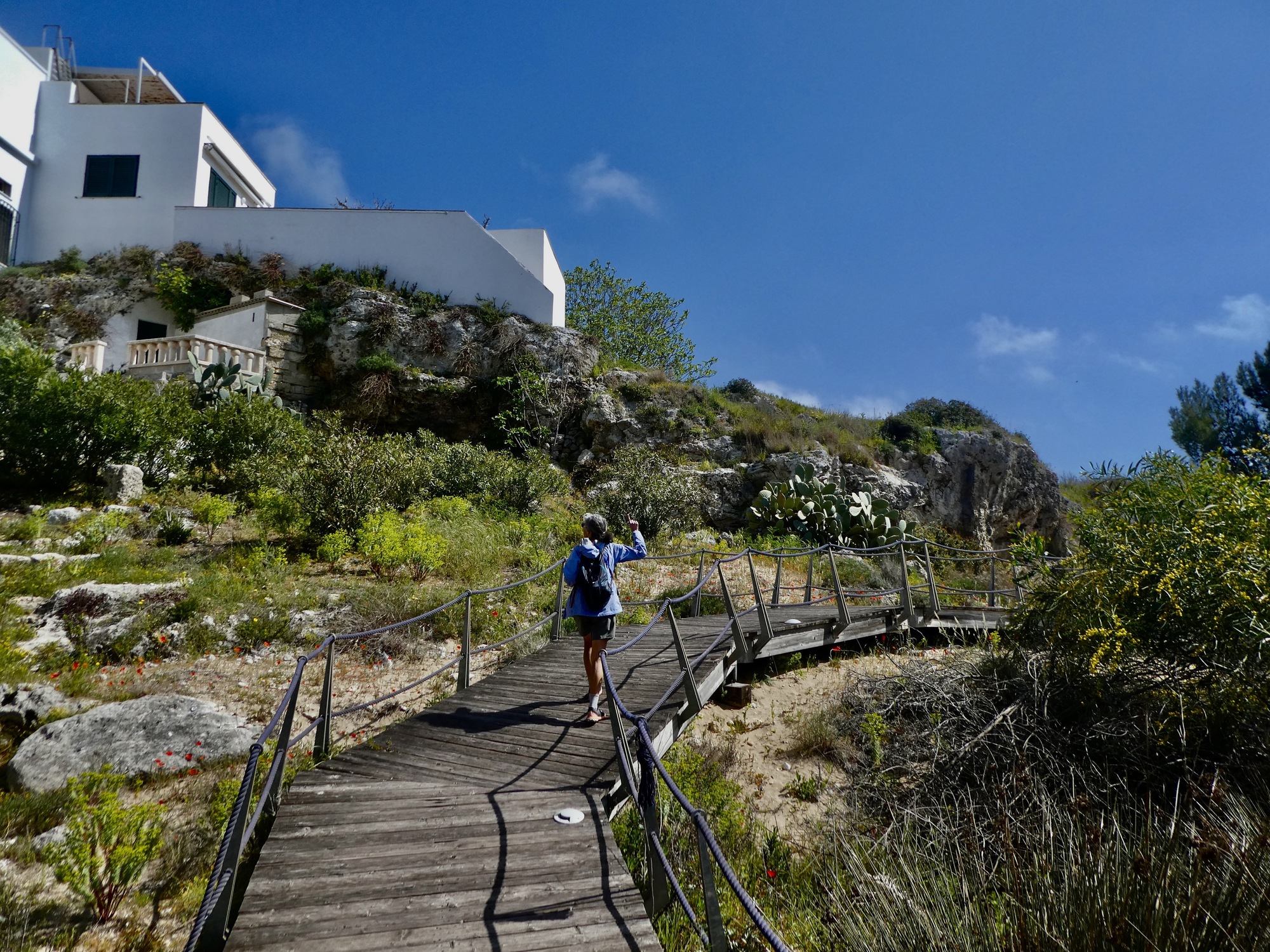April 13, 2023
In Santa Maria di Leuca
Before starting off on today’s walk, let’s take a minute to thank Bob Koreis for forwarding us this article, which answers the question that’s been nagging at us for the last few days: what are all these stone structures we’ve been biking past in Salento? Are they variants on the famous trulli we’ll see when we move further north? And are the rounded and trapezoidal ones different?
The linked article answers the question. All three are different. Trulli are found further north, so you’ll have to wait for an example (but only in this blog, of course; Susan Carpenter showed us examples from her tour of Puglia last spring so you’re likely already familiar with them).
Further south in the Salento though we start seeing the other two, and with increasing frequency as we near lands end. On much of today’s walk we passed easily dozens of them - they’re really the predominant feature of the landscape once you’re out of town. The two are different forms of dry stone peasant shelters, many of them hundreds of years old and the oldest traced back over a thousand years. The truncated conical ones are pagghiari or pajari, and the trapezoidal ones are lamie. And they’re not all these disintegrating age-old historical relics. Much of the modern construction here is built in the style of the lamie in particular - squarish, tapered, terraced structures. We saw several new ones under construction as we walked along.
So with all that verbiage behind us already, we hardly have any word space left for the walk itself. We’ll mostly let the photos and captions tell the tale today, and just point out that we’re walking because it’s very windy today - a steady 20+ mph all day long, with stronger gusts - and because walking is an excellent way to get a closer look at this unique landscape.
Well, let’s also use up some space to talk about the lighthouse, our destination for the first part of the walk. Some stolen words:
It is the second highest in Europe and is considered one of the most characteristic places of the entire Apulian town. This lighthouse 47 meters above the ground (and 102 from sea level) was designed by engineer Achille Rossi and in 1864 was activated in 1866. It emits three beams of light that are visible, in particular meteorological conditions, to beyond 40 km. In 1937 the power of the lighthouse, that up to that moment was to petroleum, was transformed in electric energy.To admire a unique view is recommended his visit: climb its 254 steps arriving at the base of the lantern, where on clear days you can see the Greek island of Corfu and the mountains on the border between Albania and Greece.

| Heart | 4 | Comment | 0 | Link |

| Heart | 5 | Comment | 0 | Link |

| Heart | 1 | Comment | 0 | Link |

| Heart | 3 | Comment | 0 | Link |

| Heart | 5 | Comment | 0 | Link |

| Heart | 4 | Comment | 0 | Link |

| Heart | 4 | Comment | 0 | Link |

| Heart | 3 | Comment | 0 | Link |
Leving the lighthouse behind, we walk more or less straight north up the peninsula. After climbing for about a half mile the route levels out into an open landscape characterized primarily by stone walls, lamie, and pagghiari. It’s an out and back, so walkers are free to set their own pace.

| Heart | 2 | Comment | 0 | Link |

| Heart | 3 | Comment | 1 | Link |
1 year ago

| Heart | 6 | Comment | 2 | Link |
https://en.wikipedia.org/wiki/Sicilian_wall_lizard
1 year ago
https://en.wikipedia.org/wiki/Italian_wall_lizard
Sicilian distribution is over most of the island of Sicily and a few nearby small islands.
https://www.lacerta.de/AF/Bibliografie/BIB_12072.pdf
1 year ago

| Heart | 3 | Comment | 1 | Link |
1 year ago

| Heart | 4 | Comment | 0 | Link |
The nine miles were enough for my knees, and I was happy after we got back to the apartment to just sit around for the next few hours until dinner. Rachael though took a break for awhile and then went out for a second short walk west along the shoreline, bringing back this short video/slide show:
| Rate this entry's writing | Heart | 10 |
| Comment on this entry | Comment | 3 |
1 year ago
1 year ago
1 year ago















1 year ago